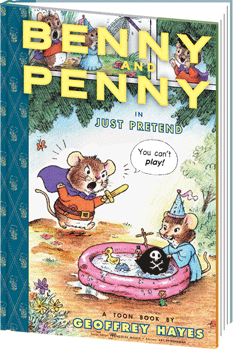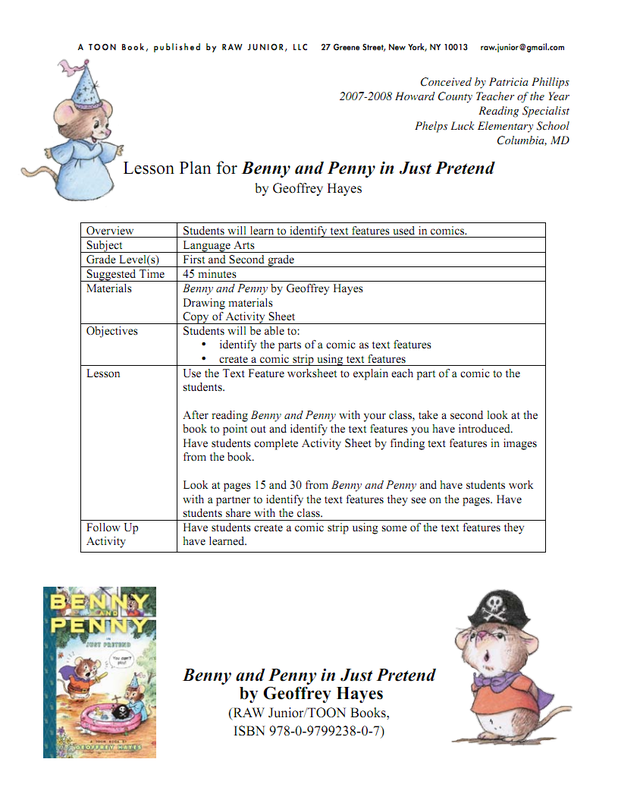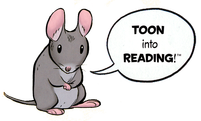Educators' Guides for Benny and Penny in Just Pretend:
TOON Books Level 2
Common Core Guide:
KEY IDEAS AND DETAILS |
|
| How are Benny and Penny related? Have students look at the last panel of page 12 and the first two panels of page 13, and see if they can guess. If they’re still having trouble, lead them to the middle panel of page 17. Does Benny want to play with Penny? How can you tell (pages 8 and 9, and 13-15)? Why does he call her a “cry-baby” on page 9? Who in the story is brave, and how does he or she show that quality? Look especially at pages 15, 27 and 28. |
RL.1.1, RL.2.1 |
| Ask students to retell the story, focusing on moments when one of the characters was upset. What upset Benny and Penny, and what made them feel better? Look at page 17 -- after you read the second panel, predict what will happen in the third | RL.1.2, RL.2.2 |
| Ask students to describe the activities that Benny and Penny like and dislike. Ask students to look at pages 27 and 28, where B&P see the dragonfly. What reactions did students expect before reading? How did they actually react? Look at pages 16 and 23 to help draw conclusions. |
RL.1.3, RL.2.3 |
CRAFT AND STRUCTURE |
|
| Have the students look at the red text on pages 15, 17 and 28. Ask them what they notice is different about it. Why do they think this text is colored red? Call students’ attention to the repeated phrase “Yo! Ho! Ho!” on pages 6, 19, and 30. Why do Benny and Penny say this phrase? What’s different about how they say it on page 30, and why do you think there’s been a change? |
RL.1.4, RL.2.4 |
| How are the animals in this story different from the ones that students might find in a book that gives information? Have students describe the game Benny is playing, and how it changes from the beginning of the story to the end. |
RL.1.5, RL.2.5 |
| Show students the speech balloons and thought ballons. What’s the difference? Have students read aloud in groups of three, with students reading different characters. |
RL.1.6, RL.2.6 |
INTEGRATION OF KNOWLEDGE AND IDEAS |
|
| Have students re-read the “hide and seek” sequence. Describe different details of the setting. In the same sequence, what happens over these pages, and how do Benny’s feelings toward his sister change? | RL.1.7, RL.2.7 |
| Have students tell the story first from Benny’s point of view and then from Penny’s point of view. Have students read the story of ‘Hansel and Gretel,’ in which a sister saves a brother from danger. What similarities and differences can students find between the two stories? Do they know other stories about siblings? |
RL.1.9, RL.2.9 |
SPEAKING AND LISTENING / WRITING |
|
| Ask students to recount their favorite part of the story. Ask them questions about the details of the story, and let other students ask questions as well. | SL.1.2, SL.1.3, SL.1.4, SL.1.6, SL.2.1, SL.2.3, SL.2.4, SL.2.6 |
| Have students write a description of an imaginary game, including the rules, what kind of equipment is used, what the objective of the game is, how long it goes on, etc. Have students exchange their ideas and comment on each others work. Allow them the opportunity to revise their work afterwards. |
W.1.2, W.2.2, W.1.5, W.2.5 |
Lesson Plan:
| Overview | Students will learn to identify text features used in comics. |
| Subject | Language Arts |
| Grade Level(s) | First and Second grade |
| SUggested Time | 45 minutes |
| Materials |
• Drawing materials • Copy of Activity Sheet |
| Objectives | Students will be able to:
• create a comic strip using text features |
| Lesson | Use the Text Feature worksheet to explain each part of a comic to the students. After reading Benny and Penny with your class, take a second look at the book to point out and identify the text features you have introduced. Have students complete Activity Sheet by finding text features in images from the book. Look at pages 15 and 30 from Benny and Penny and have students work with a partner to identify the text features they see on the pages. Have students share with the class. |
| Follow Up Activity | Have students create a comic strip using some of the text features they have learned. |
|
|
||||||||||||






